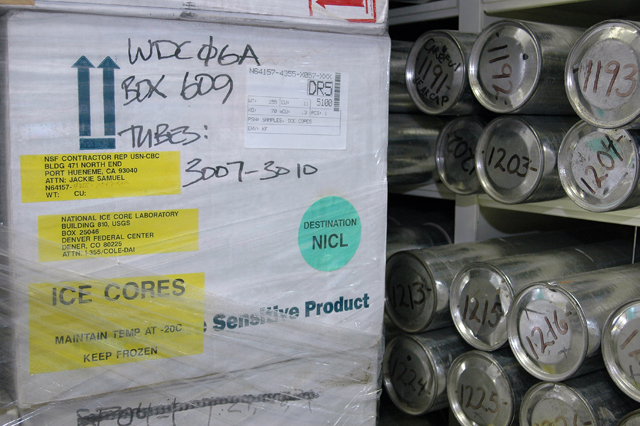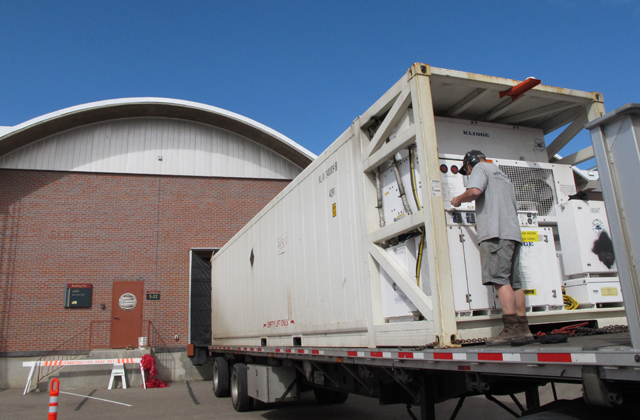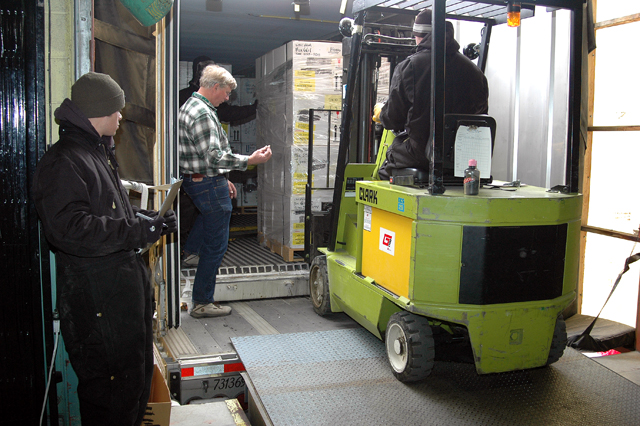Trucked inWais Divide ice cores arrive safely at NICLPosted March 25, 2011
Talk about a road trip. Three semi-trailer trucks, each pulling 20-foot-long refrigeration containers, rolled into Denver on March 15 after a 24-hour trip across the southwest corner of the country from Port Hueneme, Calif. The cargo: ice. Lots of it — about 43 pallets’ worth. But this isn’t ice for some fancy cocktail party. The trucks from California had hauled Antarctic ice cores to the National Ice Core Laboratory (NICL) It was the final leg of a journey that had covered some 11,000 miles. The trip started in a lonely, stormy spot on the West Antarctic Ice Sheet (WAIS) where scientists have drilled a continuous ice core more than two miles down. Dozens of U.S. researchers involved in the project, known as WAIS Divide The scientists are particularly excited about the WAIS Divide ice core because it promises to offer a particularly “high-resolution” record of the past 40,000 years of climate, with thick annual layers akin to tree rings. This past summer field season in Antarctica marked the end of the major drilling operations, as the team at the WAIS Divide field camp reached its target depth on Jan. 28. [See previous article: Deep core complete.] All of the ice from the field camp was flown by ski-equipped LC-130 aircraft, operated by the New York Air National Guard This is the second and final large shipment of ice for the project, according to Matthew Kippenhan, WAIS Divide project manager for Raytheon Polar Services The specially designed containers have multiple redundancies built in to ensure the ice cores arrive safely to the freezer warehouse at NICL. Each unit is outfitted with two air-conditioning units and two generators. The units can run for as long as three days on a full generator tank while it’s on the road, or if power is lost on the ship or on shore while the container is in transit. “We went through everything we could think of to make this the most fail-proof system,” Kippenhan said. A car with refrigerator mechanic Steve Mikel and Michael Davis, USAP science cargo supervisor, shadowed the trucks to troubleshoot any problems. Davis was visibly glad to arrive at NICL around 1:30 p.m., especially after a tsunami alert following the Japanese earthquake on March 11 forced the naval base to be evacuated for most of a day. 
Photo Credit: Peter Rejcek
WAIS Divide boxes stacked next to tubes containing ice cores from other projects.
“The ice was already on the truck at that point,” Davis said. Employees at NICL moved the pallets of ice cores, packed in insulated boxes, from the back of the trucks with small loaders into the facility’s warehouse, kept at a frigid minus 30 degrees Fahrenheit. The boxes occupied most of one aisle. “We were all pretty relieved to see the ice safely into the NICL freezer,” said Geoffrey Hargreaves, NICL curator. Over the next couple of weeks, the workers will unpack the cores and place the metal tubes of each three-foot section onto shelves with the rest of the WAIS Divide ice currently in storage. The arrival of 4,300 feet of core will fill the freezer to about 90 percent capacity, according to Hargreaves. That remaining 10 percent represents space for about another 2,000 three-foot-long tubes, he said. On June 1, researchers will arrive to begin processing the core for analysis at universities and institutions around the country. [See previous article: On the line.]
|



For USAP Participants |
For The Public |
For Researchers and EducatorsContact UsU.S. National Science FoundationOffice of Polar Programs Geosciences Directorate 2415 Eisenhower Avenue, Suite W7100 Alexandria, VA 22314 Sign up for the NSF Office of Polar Programs newsletter and events. Feedback Form |




